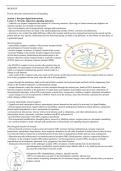Class notes
Protein structures and function in cell signaling (MCB3025F) notes
- Course
- Institution
Comprehensive lecture notes for Protein structures and function in cell signaling module covered in MCB3025F. These notes cover all content taught in lectures as well as additional materials (powerpoints, textbooks) required to succeed. These notes were created by a student who achieved a distincti...
[Show more]



